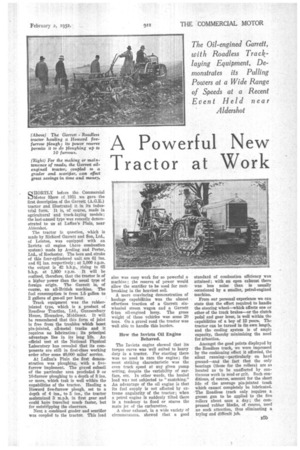A Powerful New Tractor at Work
Page 113

If you've noticed an error in this article please click here to report it so we can fix it.
The Oil-engined Garrett, with Roadless Tracklaying Equipment, Demonstrates its Pulling Powers at a Wide Range of Speeds at a Recent Event Held near Aldershot
SHORTLY before the Commercial Motor Show of 1931 we gave the first description of the Garrett (A.G.B.) tractor and illustrated it in its industrial form. It is, of course, made in agricultural and track-laying models; the last-named type was recently demonstrated to us at Laffan's Plain, near Aldershot.
The tractor in question, which is made by Richard Garrett and Son, Ltd., of Leiston, was equipped with an Invicta oil engine (Aero combustion system) made by Aveling and Porter, Ltd., of Rochester. The bore and stroke of this four-cylindered unit are 41 ins. and 61 ins. respectively ; at 1,000 r.p,m. the output is 42 b.h.p., rising to 65 b.h.p. at 1,800 r.p.m. It will be realized, therefore, that the tractor is of a higher power than the usual type of foreign origin. The Garrett is, of course, an all-British machine. The fuel consumption is from 1.5 gallon to 2 gallons of gas-oil per hour.
Track equipment was the rubberjointed type, which is a product of Roadless Traction, Ltd., Gunnersbnry House, Hounslow, Middlesex. It will be remembered that this form of joint is free from the troubles which beset pin-jointed, all-metal tracks and it requires no lubrication; its principal advantage lies in its long life. An 'official test at the National Physical Laboratory has revealed that its components are still in first-class working order after some 40,000 miles' service.
At Laffan's Plain the first demonstration was plong,hing, with a fivefurrow implement. The gravel subsoil of the particular area precluded 9 or 10-furrow ploughing to a depth of 8 ins, or more, which task is well within the capabilities of the tractor. Hauling a Howard five-furrow plough, set to a depth of 4 ins., to 5 ins., the tractor maintained 3 m.p.h, in first gear and could have travelled much faster, but for outstripping the observers.
Next a combined grader and scarifier was coupled to the tractor. This load also was easy work for so powerful a machine; the reserve of power would allow the scarifier to be used for rootbreaking in the heaviest soiL A more convincing demonstration of haulage capabilities was the almost effortless traction of a Garrett sixwheeled steam wagon and a Garrett 6-ton oil-engined lorry. The gross weight of these vehicles was some 20 tons. On a gravel road the tractor was well able to handle this burden.
How the Invicta Oil Engine Behaved.
The Invicta engine showed that its torque curve was well suited to heavy duty in a tractor. Per starting there was no need to race the engine ; the most striking characteristic was the even track speed at any given pump setting, despite the variability of surface, etc. In other words, the hauled load wa3 not subjected to "snatching." An advantage of the oil engine is that its fuel supply is not affected by extreme angularity of the tractor ; when a petrol engine is suddenly tilted there is a tendency to flood or starve the main jet of the carburetter.
A clear exhaust, in a wide variety of circumstances, showed that a good standard of combustion efficiency was attained ; with an open exhaust there was less noise than is usually occasioned by a smaller, petrol-engined machine.
From our personal experience we can state that the effort required to handle the steering wheel—which affects one or other of the track brakes—or the clutch pedal and gear lever, is well within the capabilities of a boy of 12 years. The tractor can be turned in its own length, and the cooling system is of ample capacity, thereby minimizing the need for attention.
Amongst the good points displayed by the Roadless track, we were impressed by the cushioning effect it afforded, the silent running—particularly on hard ground—and the fact that the only bearings (those for the rollers) are so located as to be unaffected by continuous work in mud or grit. Such conditions, of course, account for the short life of the average pin-jointed track which cannot completely be lubricated. The Roadless track only requires a grease gun to be applied to the five rollers about once a day ; the compressed rubber blocks, of course, need no such attention, thus eliminating a trying and difficult job.




































































































































































